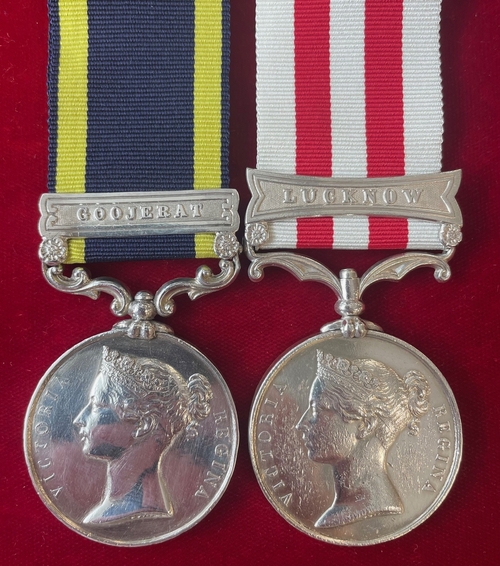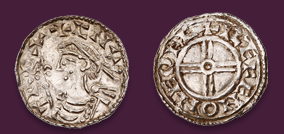
Auction: 25002 - Orders, Decorations and Medals
Lot: 88
Pair: Major H. Buck, 53rd Regiment of Foot, who commanded a detachment of his unit in the Bungaon expedition to destroy the one-armed General Gujadar Singh's contingent of mutineers, this unit was largely made up of Regiments deemed to have taken part in the Cawnpore Massacre
Punjab 1848-9, 1 clasp, Goojerat (Lieut. H. Buck, 53rd Foot.); Indian Mutiny 1857-59, 1 clasp, Lucknow (Capt. Hy. Buck, 53rd Regt.), suspension of first somewhat slack, sometime cleaned, contact marks, light edge bruising, nearly very fine (2)
M.I.D. London Gazette 25 July 1859.
Henry Buck was commissioned Ensign on 28 July 1844 he joined the Regiment in India where he was further advanced Lieutenant on 22 February 1846. Buck took part in the First Anglo-Sikh War and was present at the Battles of Aliwal and Sobraon (Medal and Clasp). Surviving this conflict the Regiment was again called upon to service in the Second Anglo-Sikh War.
Buck is noted as later taking part in actions against Hill tribes on the Peshawar Frontier from 1851-52 although this entitled him to no additional medals. Advanced Captain on 29 September 1857 he was still in India with the Regiment on the outbreak of the Indian Mutiny in 1857.
He saw action in a number of engagements through the Mutiny, notably the Action at Khosagunge, the Entry to Futtelghur and the Storm of Merungugne. Later the Regiment was heavily involved in the fighting around Lucknow, being part of Colin Campbell's final advance upon the city. After the fall of this last stronghold they did not join the Central India campaign but rather engaged in the final pacification of the rebel strongholds in Oude. As a result Buck was present for the Affair of Koossie, Occupation of Sultanpore and Action at Toolsepore.
Advanced Brevet Major on 20 July 1858 he was given command of a detachment of the 53rd and ordered to join Lieutenant-Colonel Walker's force pursuing a large party of mutineers around the town of Bangaon in Western Bengal.
'A few, more hardened in crime, and therefore more hopeless of mercy, still continued to hold out, and some of these -the regiments which had perpetrated the Kahnpur [SIC] massacre, the 1st, the 53rd, and the 56th Native Infantry, led by Gujadar Singh, a rebel whose hate to the British had not been lessened by the loss of an arm when fighting against them- succeeded in crossing the border, in marching on Sikrora, and filching thence two elephants, and finally, when pursued from that placed by Colonel Walker and the Queen's Bays, with two guns, in taking up a position at Bangaon, a small dilapidated for on the river Nadi, at the entrance of the Ghungle jungles. There, at the end of April 1859, Colonel Walker, reinforced by four hundred men of the 53rd, and sixty of the 1st Sikh cavalry, attacked and completed defeated them.' (Key and Malleson's History of the Indian Mutiny refers)
The men of the 53rd Foot cleared the fort of Bangaon and drove the rebels into the jungle with the goal of forcing them onto the rest of Walker's force. The pursuit was bloody but the vast bulk of the mutineers were totally wiped out.
'So resolute was the advance of the 53rd, that I was obliged to cease firing to allow them to enter the fort, which was taken in twelve minutes by the main body of that regiment, led in the most gallant manner by Captain Dalzell, who was the first man on the top of the bank.
Major Buck then pushed this portion of the force through the jungle to the northward, and I caused Lieutenant Prunce, with the party from B causeway, to re-enter the jungle in the same direction.' (The dispatch written by Lieutenant-Colonel B. Walker, London Gazette 25 July 1859 refers).
Sold together with copied research.
Subject to 20% VAT on Buyer’s Premium. For more information please view Terms and Conditions for Buyers.
Sold for
£800
Starting price
£400




